Java实验报告(w5-w6)
java实验报告总结_java总结范文
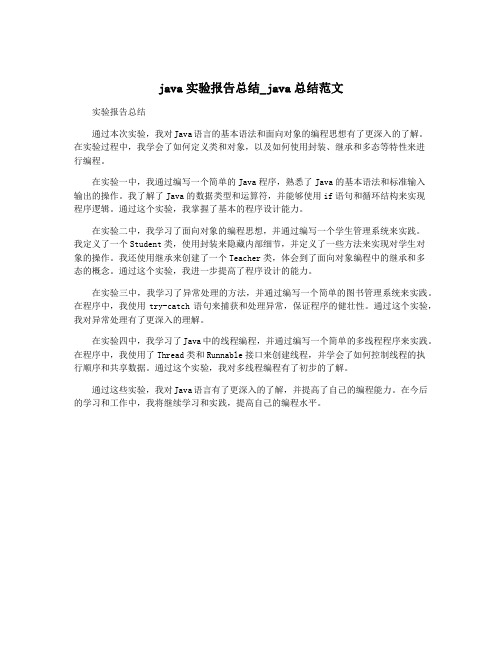
java实验报告总结_java总结范文
实验报告总结
通过本次实验,我对Java语言的基本语法和面向对象的编程思想有了更深入的了解。
在实验过程中,我学会了如何定义类和对象,以及如何使用封装、继承和多态等特性来进
行编程。
在实验一中,我通过编写一个简单的Java程序,熟悉了Java的基本语法和标准输入
输出的操作。
我了解了Java的数据类型和运算符,并能够使用if语句和循环结构来实现
程序逻辑。
通过这个实验,我掌握了基本的程序设计能力。
在实验二中,我学习了面向对象的编程思想,并通过编写一个学生管理系统来实践。
我定义了一个Student类,使用封装来隐藏内部细节,并定义了一些方法来实现对学生对
象的操作。
我还使用继承来创建了一个Teacher类,体会到了面向对象编程中的继承和多
态的概念。
通过这个实验,我进一步提高了程序设计的能力。
在实验三中,我学习了异常处理的方法,并通过编写一个简单的图书管理系统来实践。
在程序中,我使用try-catch语句来捕获和处理异常,保证程序的健壮性。
通过这个实验,我对异常处理有了更深入的理解。
在实验四中,我学习了Java中的线程编程,并通过编写一个简单的多线程程序来实践。
在程序中,我使用了Thread类和Runnable接口来创建线程,并学会了如何控制线程的执
行顺序和共享数据。
通过这个实验,我对多线程编程有了初步的了解。
通过这些实验,我对Java语言有了更深入的了解,并提高了自己的编程能力。
在今后的学习和工作中,我将继续学习和实践,提高自己的编程水平。
java基础实验报告

java基础实验报告Java基础实验报告引言:Java作为一种面向对象的编程语言,广泛应用于软件开发领域。
本次实验旨在通过一系列的实验任务,加深对Java基础知识的理解,并掌握Java编程的基本技巧。
实验一:Java环境搭建在本实验中,我们首先需要搭建Java开发环境。
Java开发工具包(JDK)是进行Java编程的基础,我们可以从Oracle官网上下载并安装最新版本的JDK。
安装完成后,我们需要配置环境变量,以便在命令行中能够直接运行Java相关的命令。
实验二:Java语言基础Java语言基础是进行Java编程的基石。
在本实验中,我们需要掌握Java的基本语法规则、数据类型和运算符等。
通过编写简单的程序,如计算两个数的和、判断一个数是否为素数等,加深对Java语言基础的理解。
实验三:面向对象编程面向对象编程是Java的核心特性之一。
在本实验中,我们需要学习Java中的类和对象的概念,并通过编写简单的类和对象来实现一些功能。
例如,创建一个学生类,包含姓名、年龄和成绩等属性,并实现一些与学生相关的操作方法。
实验四:异常处理异常处理是Java编程中重要的一部分。
在本实验中,我们需要学习Java中的异常处理机制,并通过编写代码来处理可能出现的异常情况。
例如,通过try-catch语句来捕获并处理用户输入非法字符的异常。
实验五:文件操作在实际的软件开发中,文件操作是非常常见的需求。
在本实验中,我们需要学习Java中的文件操作相关的类和方法,并通过编写代码来实现文件的读取和写入等功能。
例如,读取一个文本文件中的内容,并将其写入到另一个文件中。
实验六:多线程编程多线程编程是提高程序性能和效率的一种方式。
在本实验中,我们需要学习Java中的多线程编程相关的知识,并通过编写代码来实现多线程的应用。
例如,创建多个线程来同时下载多个文件,并实现进度条的显示。
结论:通过完成以上一系列的实验任务,我们对Java基础知识有了更深入的理解,并掌握了Java编程的基本技巧。
JAVA实验报告

JA V A实验报告实验一 Java开发环境及基本语法一、实验目的1、掌握常用的Java 集成开发环境的使用,特别是Eclipse 和NetBeans。
2、掌握Java 基本语法,重点是面向对象的思想和语法。
3、掌握控制台下(应用程序)的输入输出方法,作为后续部分实验的基础。
二、实验类型设计型。
三、实验内容1、打开实验室计算机上的集成开发环境Eclipse 或NetBeans(重点是Eclipse)了解开发软件的各个菜单功能。
会创建java 项目(Project),会编辑和编译、运行项目代码。
、。
2,验证和学习所给的几个例子程序及其讲解。
然后自己编写一个至少由一个类构成的Java 程序,其功能是在运行后,能接收用户输入一个学生的姓名以及java 课的成绩(百分制),并输出对该学生成绩是否达到60 分的及格分的判断(可使用if 语句)。
例如,输入学生姓名李明,然后输入成绩50,则输出“ 李明的成绩为不及格”。
3、编写一个程序来表示长方体的长宽高等数据并有计算体积的函数可供调用,长方体类从矩形类继承而来。
程序运行时能接受输入任意的 3 个数作为长方体的长、宽和高,然后能够输出所输入的长宽高及所计算出的体积。
注意不能把代码全部写在main 函数里面,不能直接输出长宽高的乘积。
代码如下;第一个import java.util.Scanner;public class Test{public static void main(String[] args) {String str; // 定义一个字符串变量strint i; // 定义一个整型变量iScanner sc = new Scanner(System.in); // 定义一个Scanner对象,从System.in接受输入System.out.print("输入学生姓名");str = sc.next(); // 等待用户输入任意一个字符串,它会被存到str中System.out.println("姓名:" + str); // 输出字符串strSystem.out.print("输入学生的分数:");i = sc.nextInt(); // 等待用户输入任意一个整数,它会被存到i中if(i<60)System.out.print("他的JAVA不及格,成绩是" + i );elseSystem.out.println("他的JAVA成绩是:" + i); // 输出整数i}}第二个import java.util.Scanner;public class wwh {public static void main(String[] args) {int Long; // 矩形的长int wide; // 矩形的宽int High; // 长方体的高S canner sc = new Scanner(System.in);S ystem.out.print("输入长");L ong = sc.nextInt();S ystem.out.print("输入宽");w ide=sc.nextInt();S ystem.out.print("输入高");H igh=sc.nextInt();T j T=new Tj(Long,wide,High);T.show1();}}class Vehicle{int Long; // 矩形的长int wide; // 矩形的宽Vehicle(int Long,int wide){this.Long=Long;this.wide=wide;}int getArea(){r eturn Long*wide;}void show(){System.out.println("长:"+Long);System.out.println("宽:"+wide);System.out.println("矩形的面积为; "+this.getArea()); }} //class Tj extends Vehicle{int High; // 载人数Tj(int Long,int Wide,int High){super(Long,Wide); // 调用父类的构造函数,对从父类继承而来的成员变量进行初始化this.High=High;}int getTiji(){r eturn super.getArea()*High;}void show1(){s uper.show();// 调用父类方法S ystem.out.println("长方体的高为:"+High);System.out.println("长方体的体积;"+this.getTiji());}}实验二系统类和数组一、实验目的1、通过字符串处理类的应用,掌握系统类的使用方法。
java实验报告

java实验报告Java实验报告实验名称:Java图形界面编程实验对象:Java初学者实验目的:通过实际操作掌握Java图形界面编程的基本知识和技巧实验过程:1. 实验准备:安装Java JDK开发环境,并准备好IDE工具(如Eclipse或IntelliJ IDEA)2. 创建工程:打开IDE工具,新建一个Java工程,并指定工程名和保存路径3. 创建界面:在工程上新建一个Java类,命名为"MainUI"4. 设计界面:在"MainUI"类中使用Swing或JavaFX等GUI库,设计界面布局和组件5. 添加事件监听:在"MainUI"类中添加事件监听器,使组件与逻辑代码进行关联6. 编写逻辑代码:在"MainUI"类中编写逻辑代码,实现界面交互和功能实现7. 编译运行:将工程编译成可执行文件,并运行程序,查看界面效果和功能是否符合预期8. 调试修复:根据实际运行情况,对代码进行调试和修复,确保程序的稳定性和正确性9. 测试验证:使用不同输入数据对程序进行测试,验证程序的鲁棒性和准确性10. 总结反思:对实验过程进行总结和反思,提出改进和优化的建议实验结果:通过实验,我成功创建了一个简单的Java图形界面程序,并实现了基本的交互和功能。
在界面设计方面,我使用了Swing库进行布局和组件的添加,通过事件监听器实现了按钮点击和文本框输入的监听。
在逻辑代码方面,我实现了简单的计算器功能,能够进行加减乘除等基本运算。
通过测试验证,程序运行稳定,结果准确。
实验心得:通过这次实验,我对Java图形界面编程有了更深入的了解和掌握。
我学会了使用Swing或JavaFX等库进行界面设计,以及如何添加事件监听器和编写逻辑代码。
通过实际操作,我发现编写图形界面程序相对于命令行程序更加复杂,需要考虑到用户的交互和界面布局,还需要注意代码的可读性和可维护性。
java实训报告(通用9篇)
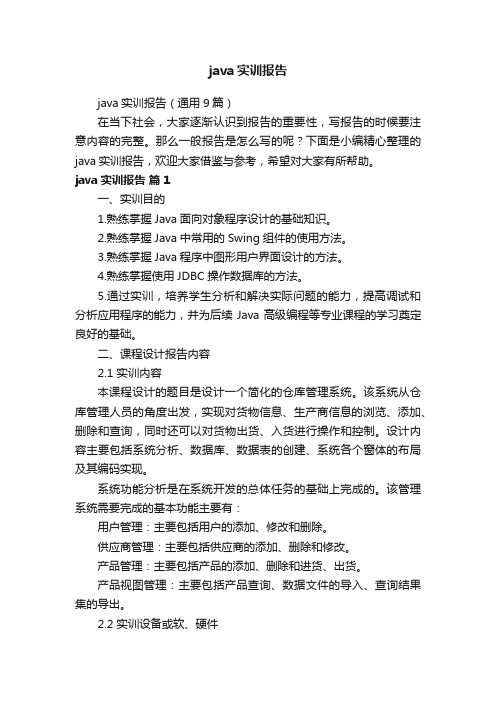
java实训报告java实训报告(通用9篇)在当下社会,大家逐渐认识到报告的重要性,写报告的时候要注意内容的完整。
那么一般报告是怎么写的呢?下面是小编精心整理的java实训报告,欢迎大家借鉴与参考,希望对大家有所帮助。
java实训报告篇1一、实训目的1.熟练掌握Java面向对象程序设计的基础知识。
2.熟练掌握Java中常用的Swing组件的使用方法。
3.熟练掌握Java程序中图形用户界面设计的方法。
4.熟练掌握使用JDBC操作数据库的方法。
5.通过实训,培养学生分析和解决实际问题的能力,提高调试和分析应用程序的能力,并为后续Java高级编程等专业课程的学习奠定良好的基础。
二、课程设计报告内容2.1 实训内容本课程设计的题目是设计一个简化的仓库管理系统。
该系统从仓库管理人员的角度出发,实现对货物信息、生产商信息的浏览、添加、删除和查询,同时还可以对货物出货、入货进行操作和控制。
设计内容主要包括系统分析、数据库、数据表的创建、系统各个窗体的布局及其编码实现。
系统功能分析是在系统开发的总体任务的基础上完成的。
该管理系统需要完成的基本功能主要有:用户管理:主要包括用户的添加、修改和删除。
供应商管理:主要包括供应商的添加、删除和修改。
产品管理:主要包括产品的添加、删除和进货、出货。
产品视图管理:主要包括产品查询、数据文件的导入、查询结果集的导出。
2.2 实训设备或软、硬件硬件:PⅣ及以上性能的PC机;软件:Windows 20xx或Windows XP系统;JDK工具;JCreator4.0环境2.3 功能设计及思想本次实训设计采用选择结构化开发方法,即用系统工程的思想和工程化的方法,按照用户至上的原则,自顶向下整体分析与设计和自底向上逐步实施的系统开发过程。
是组织、管理和控制信息系统开发过程的一种基本框架。
其基本思想:在系统分析时,采用自顶向下、逐层分解,由抽象到具体的逐步认识问题的过程;在系统设计的时候,先考虑系统整体的优化,再考虑局部的优化问题;在系统实施的时候,则坚持自底向上,先局部后整体,通过标准化模块的连接形成完整的系统。
Java实验总结报告
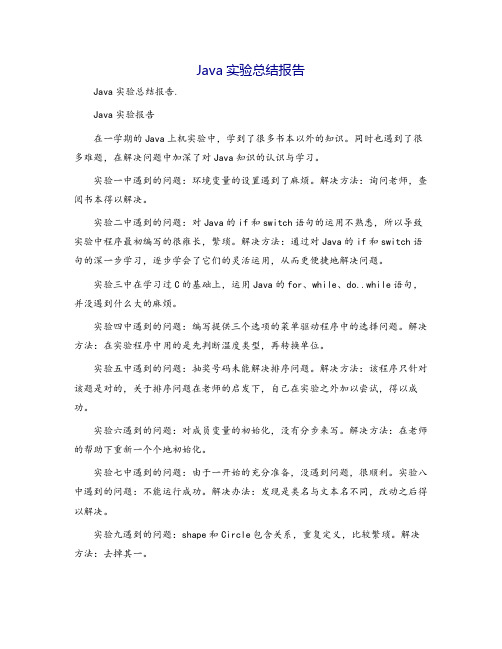
Java实验总结报告Java实验总结报告.Java实验报告在一学期的Java上机实验中,学到了很多书本以外的知识。
同时也遇到了很多难题,在解决问题中加深了对Java知识的认识与学习。
实验一中遇到的问题:环境变量的设置遇到了麻烦。
解决方法:询问老师,查阅书本得以解决。
实验二中遇到的问题:对Java的if和switch语句的运用不熟悉,所以导致实验中程序最初编写的很雍长,繁琐。
解决方法:通过对Java的if和switch语句的深一步学习,逐步学会了它们的灵活运用,从而更便捷地解决问题。
实验三中在学习过C的基础上,运用Java的for、while、do..while语句,并没遇到什么大的麻烦。
实验四中遇到的问题:编写提供三个选项的菜单驱动程序中的选择问题。
解决方法:在实验程序中用的是先判断温度类型,再转换单位。
实验五中遇到的问题:抽奖号码未能解决排序问题。
解决方法:该程序只针对该题是对的,关于排序问题在老师的启发下,自己在实验之外加以尝试,得以成功。
实验六遇到的问题:对成员变量的初始化,没有分步来写。
解决方法:在老师的帮助下重新一个个地初始化。
实验七中遇到的问题:由于一开始的充分准备,没遇到问题,很顺利。
实验八中遇到的问题:不能运行成功。
解决办法:发现是类名与文本名不同,改动之后得以解决。
实验九遇到的问题:shape和Circle包含关系,重复定义,比较繁琐。
解决方法:去掉其一。
实验十遇到的问题:在理解并使用面向对象的特征:多态实验上还算顺利。
实验十一遇到的问题:对线程的基本概念模糊,走了很多弯路。
解决方法:请教同学,参照课本最终才勉强解决了问题。
学习心得与体会:在做完所有实验后,我初步理解并能够操作和使用Java的if和switch,for、while、do..while语句,Java的类、对象和方法,声明、定义和调用方法,理解实参和形参的含义。
学习创建简单类型的数组,并能用循环语句处理数组。
使用统一建模语言(UML)设计类,并实现类。
JAVA实验报告

实验一:实验目的●学习下载最新版本的JDK。
●学习安装与设置JDK运行环境。
●解决JDK开发环境配置中的常见问题。
实验二:实验目的●了解Java应用程序的结构。
●学习Java应用程序源程序的编辑。
●学习Java源程序的编译。
●学习Java应用程序的运行。
●学习解决Java源程序编译过程中的常见问题。
实验要求编写一个比较简单的Java应用程序,该程序将会在命令提示符窗口下输出一句话:Java 世界欢迎你!实验三:实验目的●了解Java小程序的结构。
●学习Java小程序的编译、运行。
●了解Html语言中的Applet标签。
实验四:实验目的●学习标识符的命名规则。
●学习基本数据类型变量的声明。
●学习基本数据类型变量的初始化。
●明确局部变量使用前初始化的意义。
●学习常量的使用。
实验要求编写一个Java 程序,在程序中声明各种基本数据类型的变量,对它们进行初始化,再显示它们各自的值;定义一个双精度数据类型的常量,并显示它的值。
实验五:实验目的●学习算术运算符中的求模运算。
●学习算术运算符中的自增运算。
●学习算术运算符中的自减运算。
实验要求编写一个Java 程序,在程序中进行求模运算、自增和自减运算。
实验五:实验目的●学习算术运算符中的求模运算。
●学习算术运算符中的自增运算。
●学习算术运算符中的自减运算。
实验要求编写一个Java 程序,在程序中进行求模运算、自增和自减运算。
实验六:实验目的●学习算术运算符中的整数除法。
●学习算术运算符中的浮点数除法。
●学习算术运算符中的整数与浮点数混合除法。
实验要求编写一个Java 程序,在程序中进行整数除法、浮点数除法和整数与浮点数混合除法运算。
实验七:实验目的●学习逻辑运算符中的与运算。
●学习逻辑运算符中的或运算。
●学习逻辑运算符中的非运算。
实验要求编写一个Java 程序,在程序中进行与运算、或运算和非运算。
实验八:实验目的●学习字符串转换为数值型数据的方法。
●学习数值型数据转换成字符串的方法。
java实验报告实验原理
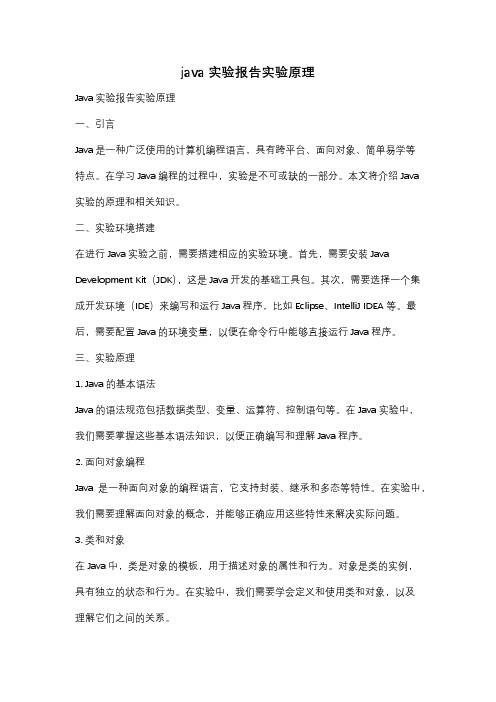
java实验报告实验原理Java实验报告实验原理一、引言Java是一种广泛使用的计算机编程语言,具有跨平台、面向对象、简单易学等特点。
在学习Java编程的过程中,实验是不可或缺的一部分。
本文将介绍Java实验的原理和相关知识。
二、实验环境搭建在进行Java实验之前,需要搭建相应的实验环境。
首先,需要安装Java Development Kit(JDK),这是Java开发的基础工具包。
其次,需要选择一个集成开发环境(IDE)来编写和运行Java程序,比如Eclipse、IntelliJ IDEA等。
最后,需要配置Java的环境变量,以便在命令行中能够直接运行Java程序。
三、实验原理1. Java的基本语法Java的语法规范包括数据类型、变量、运算符、控制语句等。
在Java实验中,我们需要掌握这些基本语法知识,以便正确编写和理解Java程序。
2. 面向对象编程Java是一种面向对象的编程语言,它支持封装、继承和多态等特性。
在实验中,我们需要理解面向对象的概念,并能够正确应用这些特性来解决实际问题。
3. 类和对象在Java中,类是对象的模板,用于描述对象的属性和行为。
对象是类的实例,具有独立的状态和行为。
在实验中,我们需要学会定义和使用类和对象,以及理解它们之间的关系。
4. 异常处理Java提供了异常处理机制,可以捕获和处理程序中的异常情况。
在实验中,我们需要学会使用try-catch语句来捕获异常,并进行相应的处理,以保证程序的稳定性和可靠性。
5. 输入输出Java提供了丰富的输入输出功能,可以从键盘读取输入,也可以将结果输出到控制台或文件中。
在实验中,我们需要学会使用Java提供的输入输出类和方法,以便与用户进行交互和展示程序的结果。
6. 集合框架Java的集合框架提供了一系列的数据结构和算法,用于存储和操作数据。
在实验中,我们需要学会使用集合框架提供的各种数据结构,比如List、Set、Map 等,以及相应的操作方法,比如添加、删除、查找等。
java实验五报告

实验5 Java中的输入、输出实验时间:2012年12月4日一、实验目的与要求1、掌握Java输入、输出流的使用方法。
2、学习异常处理二、实验内容1、利用输入输出流,从键盘读取整数、字符串等,并把它们赋给相应变量,从屏幕输出。
2、利用输入、输出流从某.txt文件读取数据,并把结果保存到另外一个.txt文件。
三、实验器材微机+windows操作系统+eclipse四、实验步骤import java.io.*;public class jianpanshuru {public static void main(String[] args) {// TODO Auto-generated method stubtry{//键盘数据输入InputStream is=System.in;//创建InputStream对象InputStreamReader isr=new InputStreamReader(is);BufferedReader br=new BufferedReader(isr);String s=null;System.out.print("请输入一行内容:");while((s=br.readLine())!=null&&s.length()!=0){System.out.println("您输入的内容为:"+s);int ii=Integer.parseInt(s);System.out.println("输入的整数是:"+ii);}}catch(IOException e){e.printStackTrace();}try{ ///txt文件复制FileReader fr=new FileReader("D:\\lianxi\\2.txt");BufferedReader bf=new BufferedReader(fr);FileWriter fw=new FileWriter("D:\\lianxi\\4.txt");BufferedWriter bw=new BufferedWriter(fw);PrintWriter pw=new PrintWriter(bw);String ss="";while((ss=bf.readLine())!=null){System.out.println(ss);ss=ss+"\r\n";pw.write(ss);pw.flush();}pw.close();}catch(IOException e){System.out.println(e);}}}五、实验结果键盘输入实验结果请输入一行内容:56您输入的内容为:56输入的整数是:56java您输入的内容为:javaException in thread "main" ng.NumberFormatException: For input string: "java"文件复制实验结果文件内容为:2 3 4 南昌理工学院六、实验小结1、通过这个实验加深了对输入流的理解:InputStream可以把字节流转换成字符流;InputStreamReader 用来处理字符流;BufferedReader给字符流增加缓冲区。
JAVA第五次实验报告

JAVA第五次实验报告实验五:数组的引用类型与多态性实验目的:1.掌握数组的引用类型和多态性的概念和使用。
2. 熟悉Java中数组的创建、初始化和遍历。
3.理解多态性的概念和实现方式。
4. 掌握Java中类和对象的定义和使用。
实验过程:1. 创建了一个名为"Person"的类,拥有一个私有成员变量"name"和一个公有的构造方法和一个公有的成员方法printName(。
2. 创建了一个名为"Student"的类,作为Person类的子类,拥有一个私有成员变量"grade"和一个公有的构造方法和一个公有的覆盖了父类方法的成员方法printName(。
3. 创建了一个名为"Teacher"的类,作为Person类的子类,拥有一个私有成员变量"subject"和一个公有的构造方法和一个公有的覆盖了父类方法的成员方法printName(。
4. 在主函数中,创建了一个长度为5的Person类型的数组,并分别实例化了两个Student对象和两个Teacher对象,并将这四个对象赋值给数组的前四个元素。
5. 遍历数组,调用每个对象的printName(方法,分别输出每个对象的名称。
实验结果:运行程序后,实验结果如下:Student - 1Student - 2Teacher - 1Teacher - 2实验分析:通过以上实验,我们可以看到数组可以存储同一父类引用类型的不同子类对象,这种特性称为多态性。
在遍历数组时,可以调用每个对象的方法,实现多态的效果。
在本实验中,通过将两个Student对象和两个Teacher对象赋值给Person类型的数组,我们实现了多态性。
在遍历数组时,调用每个对象的printName(方法,程序会根据对象的具体类型执行对应的方法。
实验总结:通过本次实验,我学会了如何使用数组的引用类型和多态性。
Java实验报告

引言概述:Java实验报告(二)是对Java编程语言的实验进行的总结与分析。
本文将通过对实验过程中的操作和结果进行详细阐述,对Java的特性和应用进行深入探索,以及提供了一系列实验结果和实验过程中的问题及解决方案。
本文共分为引言概述、正文内容、总结三个部分。
正文内容:一、Java语言基础1.1Java的历史和特点1.2Java语言的基本特性1.3Java的运行机制1.4Java的数据类型和变量1.5Java中的运算符和表达式二、控制流语句与循环结构2.1条件控制语句2.2循环结构2.3跳转语句三、面向对象编程3.1类与对象3.2封装、继承与多态3.3抽象类与接口3.4异常处理3.5文件操作与IO流四、Java核心技术4.1Java集合框架4.2多线程编程4.3网络编程4.4GUI开发4.5数据库连接和操作五、Java应用案例分析5.1图书管理系统5.2学生信息管理系统5.3电子商务系统5.4银行管理系统5.5在线聊天程序总结:在Java实验报告(二)中,我们系统地学习了Java语言的基础知识、控制流语句与循环结构、面向对象编程、Java核心技术以及Java应用案例分析。
通过实验和实践,我们提高了对Java编程语言的理解和应用能力,为今后的学习和工作奠定了坚实的基础。
希望通过这次实验报告的撰写,能够对读者们对Java编程语言有更全面和深入的认识,激发对于编程的兴趣和灵感。
引言:Java是一种面向对象的编程语言,具有跨平台、高性能和可靠性等优点。
本文将对Java实验进行详细报告,包括实验目的、实验方法、实验结果及分析、问题和解决方案等方面。
概述:本次实验旨在通过编写Java程序,加深对Java语言及其相关知识的理解和掌握。
实验主要分为五个大点,包括环境搭建、基本语法、面向对象编程、异常处理和文件操作。
每个大点将分别进行详细阐述。
正文内容:1.环境搭建1.1安装JDK1.2配置环境变量1.3设置IDE2.基本语法2.1数据类型2.2变量和常量2.3运算符2.4控制语句2.5循环语句3.面向对象编程3.1类和对象3.2继承3.3多态3.4封装3.5接口和抽象类4.异常处理4.1异常的概念4.2异常处理机制4.3trycatch语句4.4finally语句4.5自定义异常5.文件操作5.1文件的读写5.2文件的创建和删除5.3文件的复制和移动5.4文件的压缩和解压缩5.5文件的读写性能优化实验结果及分析:通过实验,我们成功搭建了Java开发环境,并学习了Java的基本语法、面向对象编程、异常处理和文件操作等知识。
java实验报告五

java实验报告五Java实验报告五一、引言Java是一种面向对象的编程语言,具有跨平台性、安全性和易学性等特点。
本实验报告将介绍我们在学习Java过程中进行的第五个实验。
二、实验目的本次实验的主要目的是通过实践进一步熟悉Java的基本语法和面向对象的编程思想,并掌握Java中的异常处理机制。
三、实验内容本次实验主要分为两个部分:实现一个简单的图书管理系统和异常处理。
3.1 图书管理系统我们设计了一个简单的图书管理系统,主要包括图书类、用户类和图书管理类。
图书类包含图书的基本信息,如书名、作者、出版社等;用户类包含用户的基本信息,如姓名、年龄、性别等;图书管理类实现了对图书和用户的管理功能,如添加图书、删除图书、借阅图书等。
3.2 异常处理在图书管理系统中,我们使用了异常处理机制来处理一些可能发生的异常情况,如图书馆中没有要借阅的图书、图书已被借完等。
我们使用try-catch语句来捕获异常,并根据具体情况进行相应的处理。
四、实验过程4.1 图书管理系统的实现首先,我们定义了图书类和用户类,并在类中定义了相应的属性和方法。
然后,我们创建了一个图书管理类,并在该类中实现了对图书和用户的管理功能。
最后,我们编写了一个测试类,通过创建对象并调用相应的方法来测试图书管理系统的功能是否正常。
4.2 异常处理在图书管理类的方法中,我们使用了try-catch语句来捕获可能发生的异常。
当出现异常时,程序会跳转到catch块中,并执行相应的处理代码。
我们根据具体情况,输出相应的错误信息或进行其他操作,以保证程序的正常运行。
五、实验结果通过测试,我们发现图书管理系统的功能正常运行,并且能够正确处理可能发生的异常情况。
我们成功添加了图书、删除了图书,并能够正确借阅和归还图书。
六、实验总结通过本次实验,我们进一步熟悉了Java的基本语法和面向对象的编程思想。
我们学会了如何设计和实现一个简单的图书管理系统,并掌握了异常处理的基本方法。
java实验报告:实验六

java实验报告:实验六一、实验目的本次实验的主要目的是深入理解和掌握 Java 中的一些关键概念和技术,包括面向对象编程的特性、异常处理机制以及文件操作等。
通过实际的编程实践,提高我们运用 Java 解决实际问题的能力。
二、实验环境本次实验使用的开发工具是 IntelliJ IDEA,操作系统为 Windows 10。
三、实验内容(一)面向对象编程实践1、定义一个名为“Student”的类,包含学生的姓名、学号和成绩等属性,并实现相应的 getter 和 setter 方法。
2、在主函数中创建“Student”类的对象,并对其属性进行赋值和输出。
(二)异常处理1、编写一个方法,实现两数相除的运算。
如果除数为 0,抛出“ArithmeticException”异常。
2、在主函数中调用该方法,并使用trycatch 语句捕获并处理异常。
(三)文件操作1、创建一个文本文件,并向其中写入一些数据。
2、读取该文件中的数据,并将其输出到控制台。
四、实验步骤(一)面向对象编程实践1、首先,在 IntelliJ IDEA 中创建一个新的 Java 项目。
2、然后,创建“Student”类,代码如下:```javapublic class Student {private String name;private int studentId;private double score;public String getName(){return name;}public void setName(String name) {thisname = name;}public int getStudentId(){return studentId;}public void setStudentId(int studentId) {thisstudentId = studentId;}public double getScore(){return score;}public void setScore(double score) {thisscore = score;}}```3、在主函数中创建“Student”类的对象,并对其属性进行赋值和输出,代码如下:```javapublic class Main {public static void main(String args) {Student student = new Student();studentsetName("张三");studentsetStudentId(1001);studentsetScore(905);Systemoutprintln("学生姓名:"+ studentgetName());Systemoutprintln("学生学号:"+ studentgetStudentId());Systemoutprintln("学生成绩:"+ studentgetScore());}}```(二)异常处理1、编写一个名为“divide”的方法,实现两数相除的运算,代码如下:```javapublic class ExceptionHandling {public static double divide(double num1, double num2) {if (num2 == 0) {throw new ArithmeticException("除数不能为 0");}return num1 / num2;}public static void main(String args) {try {double result = divide(10, 0);Systemoutprintln("结果:"+ result);} catch (ArithmeticException e) {Systemoutprintln("捕获到异常:"+ egetMessage());}}}```(三)文件操作1、创建一个名为“FileOperation”的类,用于实现文件的写入和读取操作,代码如下:```javaimport javaioBufferedWriter;import javaioFileWriter;import javaioIOException;import javaioBufferedReader;import javaioFileReader;public class FileOperation {public static void writeToFile(String filePath, String content) {try (BufferedWriter writer = new BufferedWriter(new FileWriter(filePath))){writerwrite(content);} catch (IOException e) {eprintStackTrace();}}public static String readFromFile(String filePath) {StringBuilder content = new StringBuilder();try (BufferedReader reader = new BufferedReader(new FileReader(filePath))){String line;while ((line = readerreadLine())!= null) {contentappend(line)append("\n");}} catch (IOException e) {eprintStackTrace();}return contenttoString();}public static void main(String args) {String filePath ="testtxt";String data ="这是写入文件的内容";writeToFile(filePath, data);String readData = readFromFile(filePath);Systemoutprintln("读取到的文件内容:\n" + readData);}}```五、实验结果(一)面向对象编程实践成功创建了“Student”类的对象,并正确地对其属性进行了赋值和输出。
java实验报告实验报告java实验报告Java
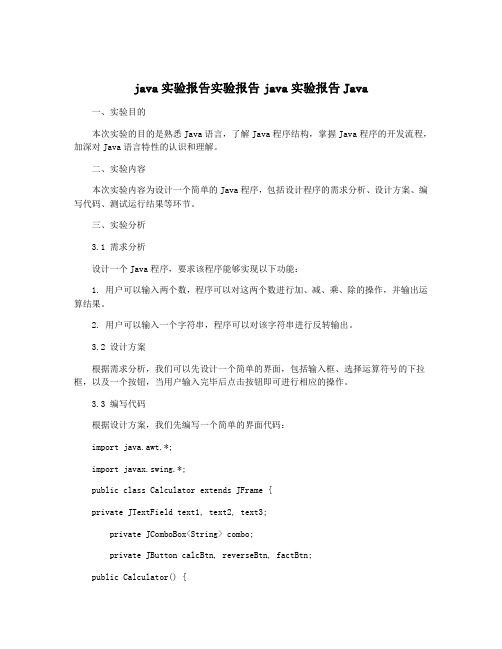
java实验报告实验报告java实验报告Java一、实验目的本次实验的目的是熟悉Java语言,了解Java程序结构,掌握Java程序的开发流程,加深对Java语言特性的认识和理解。
二、实验内容本次实验内容为设计一个简单的Java程序,包括设计程序的需求分析、设计方案、编写代码、测试运行结果等环节。
三、实验分析3.1 需求分析设计一个Java程序,要求该程序能够实现以下功能:1. 用户可以输入两个数,程序可以对这两个数进行加、减、乘、除的操作,并输出运算结果。
2. 用户可以输入一个字符串,程序可以对该字符串进行反转输出。
3.2 设计方案根据需求分析,我们可以先设计一个简单的界面,包括输入框、选择运算符号的下拉框,以及一个按钮,当用户输入完毕后点击按钮即可进行相应的操作。
3.3 编写代码根据设计方案,我们先编写一个简单的界面代码:import java.awt.*;import javax.swing.*;public class Calculator extends JFrame {private JTextField text1, text2, text3;private JComboBox<String> combo;private JButton calcBtn, reverseBtn, factBtn;public Calculator() {super("Calculator");text1 = new JTextField(5);text2 = new JTextField(5);text3 = new JTextField(10);combo = new JComboBox<String>(new String[]{"+", "-", "*", "/"});calcBtn = new JButton("Calculate");reverseBtn = new JButton("Reverse");factBtn = new JButton("Factorial");JPanel panel2 = new JPanel();panel2.add(new JLabel("String:"));panel2.add(text3);panel2.add(reverseBtn);pack();setVisible(true);setDefaultCloseOperation(EXIT_ON_CLOSE);}该界面中包含了3个面板,一个用于加减乘除,一个用于字符串反转,一个用于阶乘操作。
java实验报告
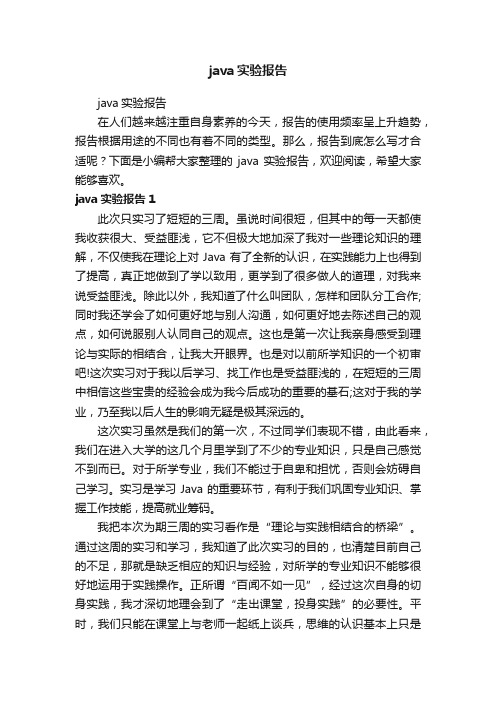
java实验报告java实验报告在人们越来越注重自身素养的今天,报告的使用频率呈上升趋势,报告根据用途的不同也有着不同的类型。
那么,报告到底怎么写才合适呢?下面是小编帮大家整理的java实验报告,欢迎阅读,希望大家能够喜欢。
java实验报告1此次只实习了短短的三周。
虽说时间很短,但其中的每一天都使我收获很大、受益匪浅,它不但极大地加深了我对一些理论知识的理解,不仅使我在理论上对Java有了全新的认识,在实践能力上也得到了提高,真正地做到了学以致用,更学到了很多做人的道理,对我来说受益匪浅。
除此以外,我知道了什么叫团队,怎样和团队分工合作;同时我还学会了如何更好地与别人沟通,如何更好地去陈述自己的观点,如何说服别人认同自己的观点。
这也是第一次让我亲身感受到理论与实际的相结合,让我大开眼界。
也是对以前所学知识的一个初审吧!这次实习对于我以后学习、找工作也是受益匪浅的,在短短的三周中相信这些宝贵的经验会成为我今后成功的重要的基石;这对于我的学业,乃至我以后人生的影响无疑是极其深远的。
这次实习虽然是我们的第一次,不过同学们表现不错,由此看来,我们在进入大学的这几个月里学到了不少的专业知识,只是自己感觉不到而已。
对于所学专业,我们不能过于自卑和担忧,否则会妨碍自己学习。
实习是学习Java的重要环节,有利于我们巩固专业知识、掌握工作技能,提高就业筹码。
我把本次为期三周的实习看作是“理论与实践相结合的桥梁”。
通过这周的实习和学习,我知道了此次实习的目的,也清楚目前自己的不足,那就是缺乏相应的知识与经验,对所学的专业知识不能够很好地运用于实践操作。
正所谓“百闻不如一见”,经过这次自身的切身实践,我才深切地理会到了“走出课堂,投身实践”的必要性。
平时,我们只能在课堂上与老师一起纸上谈兵,思维的认识基本上只是局限于课本的范围之内,也许就是这个原因就导致我们对专业知识认识的片面性,使得我们只知所以然,而不知其之所以然!限制了我们网络知识水平的提高。
java编程基础实验报告
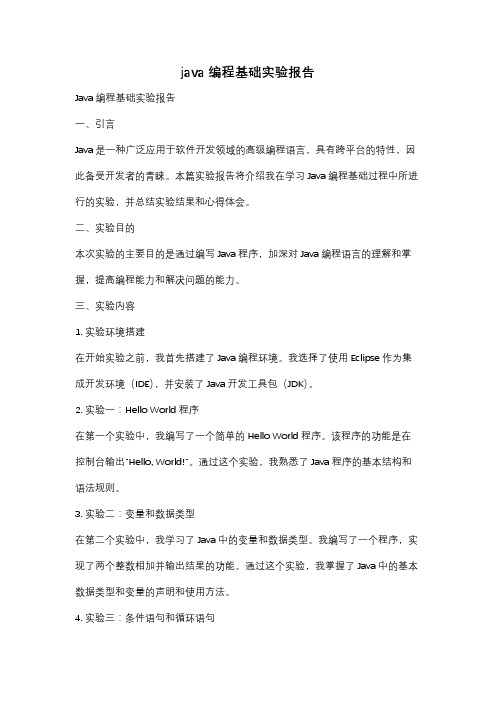
java编程基础实验报告Java编程基础实验报告一、引言Java是一种广泛应用于软件开发领域的高级编程语言,具有跨平台的特性,因此备受开发者的青睐。
本篇实验报告将介绍我在学习Java编程基础过程中所进行的实验,并总结实验结果和心得体会。
二、实验目的本次实验的主要目的是通过编写Java程序,加深对Java编程语言的理解和掌握,提高编程能力和解决问题的能力。
三、实验内容1. 实验环境搭建在开始实验之前,我首先搭建了Java编程环境。
我选择了使用Eclipse作为集成开发环境(IDE),并安装了Java开发工具包(JDK)。
2. 实验一:Hello World程序在第一个实验中,我编写了一个简单的Hello World程序。
该程序的功能是在控制台输出"Hello, World!"。
通过这个实验,我熟悉了Java程序的基本结构和语法规则。
3. 实验二:变量和数据类型在第二个实验中,我学习了Java中的变量和数据类型。
我编写了一个程序,实现了两个整数相加并输出结果的功能。
通过这个实验,我掌握了Java中的基本数据类型和变量的声明和使用方法。
4. 实验三:条件语句和循环语句在第三个实验中,我学习了Java中的条件语句和循环语句。
我编写了一个程序,实现了判断一个数是否为偶数并输出结果的功能。
通过这个实验,我掌握了Java中的if语句和for循环语句的使用方法。
5. 实验四:数组和字符串在第四个实验中,我学习了Java中的数组和字符串。
我编写了一个程序,实现了对一个整型数组进行排序并输出结果的功能。
通过这个实验,我掌握了Java中数组的声明和使用方法,以及字符串的操作方法。
6. 实验五:面向对象编程在第五个实验中,我学习了Java中的面向对象编程。
我编写了一个程序,实现了一个简单的学生信息管理系统。
通过这个实验,我掌握了Java中类的定义和对象的创建与使用方法。
四、实验结果通过以上实验,我成功编写了各种Java程序,并在控制台输出了预期的结果。
javaweb实训实验报告
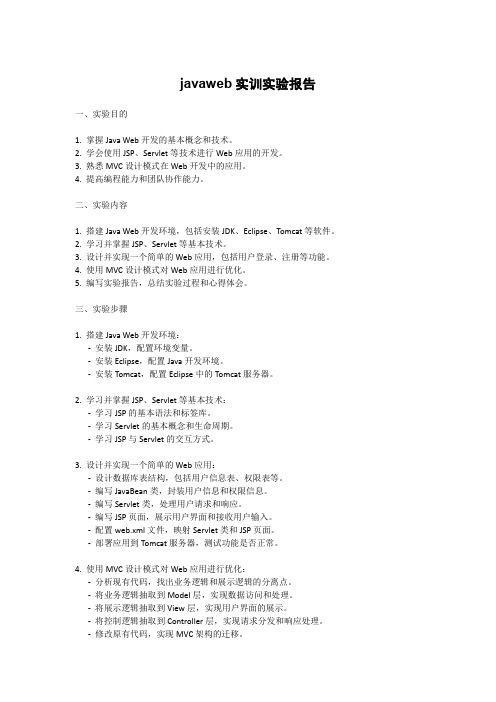
javaweb实训实验报告一、实验目的1. 掌握Java Web开发的基本概念和技术。
2. 学会使用JSP、Servlet等技术进行Web应用的开发。
3. 熟悉MVC设计模式在Web开发中的应用。
4. 提高编程能力和团队协作能力。
二、实验内容1. 搭建Java Web开发环境,包括安装JDK、Eclipse、Tomcat等软件。
2. 学习并掌握JSP、Servlet等基本技术。
3. 设计并实现一个简单的Web应用,包括用户登录、注册等功能。
4. 使用MVC设计模式对Web应用进行优化。
5. 编写实验报告,总结实验过程和心得体会。
三、实验步骤1. 搭建Java Web开发环境:-安装JDK,配置环境变量。
-安装Eclipse,配置Java开发环境。
-安装Tomcat,配置Eclipse中的Tomcat服务器。
2. 学习并掌握JSP、Servlet等基本技术:-学习JSP的基本语法和标签库。
-学习Servlet的基本概念和生命周期。
-学习JSP与Servlet的交互方式。
3. 设计并实现一个简单的Web应用:-设计数据库表结构,包括用户信息表、权限表等。
-编写JavaBean类,封装用户信息和权限信息。
-编写Servlet类,处理用户请求和响应。
-编写JSP页面,展示用户界面和接收用户输入。
-配置web.xml文件,映射Servlet类和JSP页面。
-部署应用到Tomcat服务器,测试功能是否正常。
4. 使用MVC设计模式对Web应用进行优化:-分析现有代码,找出业务逻辑和展示逻辑的分离点。
-将业务逻辑抽取到Model层,实现数据访问和处理。
-将展示逻辑抽取到View层,实现用户界面的展示。
-将控制逻辑抽取到Controller层,实现请求分发和响应处理。
-修改原有代码,实现MVC架构的迁移。
-测试MVC架构下的应用功能是否正常。
四、实验结果与分析1. 成功搭建了Java Web开发环境,包括安装了JDK、Eclipse、Tomcat等软件。
java实验报告
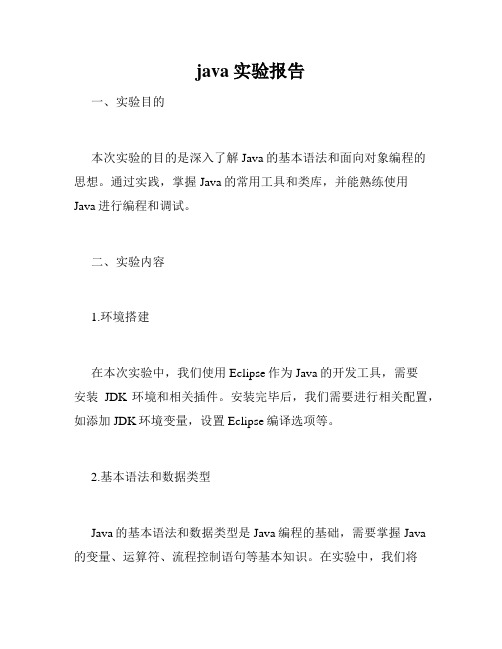
java实验报告一、实验目的本次实验的目的是深入了解Java的基本语法和面向对象编程的思想。
通过实践,掌握Java的常用工具和类库,并能熟练使用Java进行编程和调试。
二、实验内容1.环境搭建在本次实验中,我们使用Eclipse作为Java的开发工具,需要安装JDK环境和相关插件。
安装完毕后,我们需要进行相关配置,如添加JDK环境变量,设置Eclipse编译选项等。
2.基本语法和数据类型Java的基本语法和数据类型是Java编程的基础,需要掌握Java的变量、运算符、流程控制语句等基本知识。
在实验中,我们将会练习Java的语法和数据类型的使用,如输出文本、计算数值、定义变量等。
3.面向对象编程思想Java是一门面向对象的编程语言,面向对象思想是Java编程的核心。
在本次实验中,我们将学习Java的类、对象、继承、多态等面向对象的知识,并通过实践来理解和熟悉Java面向对象编程的思想。
4.常用类库和工具Java有丰富的类库和工具,如集合类、IO类、网络编程类等。
在本次实验中,我们将会了解并运用Java的常用类库和工具来实现一些简单的功能,如读写文件、网络通信等。
三、实验步骤1.环境搭建与配置安装JDK环境和Eclipse开发工具,并将JDK环境添加到系统环境变量中。
然后进入Eclipse,设置编译选项和相关插件,如Java自动补全、eclipse编译和调试工具等。
2.基本语法和数据类型基于Java的基本语法和数据类型,我们可以编写一些简单的程序,如输出HelloWorld、计算数字和变量赋值等。
这些程序可以通过Eclipse自带的编译器进行调试和运行。
3.面向对象编程思想通过学习Java的面向对象编程思想,我们可以定义一个类和对应的对象,使用继承和多态来实现复杂的业务逻辑,并使用接口和内部类等技术来封装数据和实现较复杂的功能。
4.常用类库和工具在实践中,我们会用到常用的类库和工具,如java.io包和包。
【优质】java实验报告六-word范文 (5页)
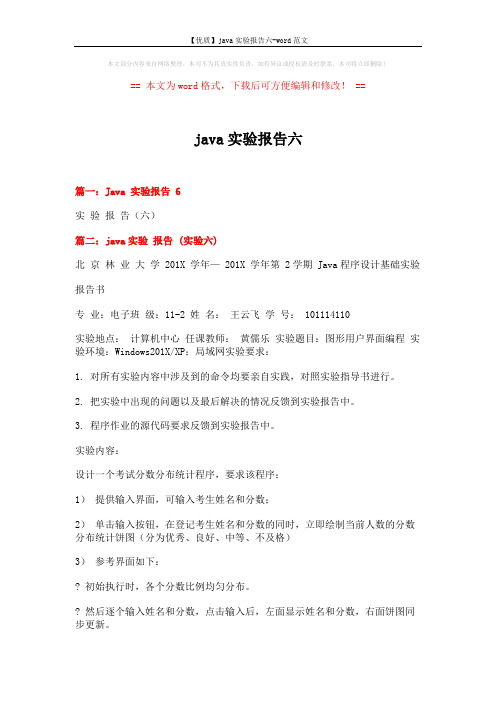
本文部分内容来自网络整理,本司不为其真实性负责,如有异议或侵权请及时联系,本司将立即删除!== 本文为word格式,下载后可方便编辑和修改! ==java实验报告六篇一:Java 实验报告 6实验报告(六)篇二:java实验报告 (实验六)北京林业大学 201X 学年— 201X 学年第 2学期 Java程序设计基础实验报告书专业:电子班级:11-2 姓名:王云飞学号: 101114110实验地点:计算机中心任课教师:黄儒乐实验题目:图形用户界面编程实验环境:Windows201X/XP;局域网实验要求:1. 对所有实验内容中涉及到的命令均要亲自实践,对照实验指导书进行。
2. 把实验中出现的问题以及最后解决的情况反馈到实验报告中。
3. 程序作业的源代码要求反馈到实验报告中。
实验内容:设计一个考试分数分布统计程序,要求该程序:1)提供输入界面,可输入考生姓名和分数;2)单击输入按钮,在登记考生姓名和分数的同时,立即绘制当前人数的分数分布统计饼图(分为优秀、良好、中等、不及格)3)参考界面如下:? 初始执行时,各个分数比例均匀分布。
? 然后逐个输入姓名和分数,点击输入后,左面显示姓名和分数,右面饼图同步更新。
实验目的:掌握图形用户界面中常用类的使用。
实现方法、实验结果及结论分析等:实验源代码:import java.awt.event.*;import java.awt.*;import javax.swing.*;public class Score extends JFrame{JPanel inputPanel=new JPanel();ShanXingTu figure =new ShanXingTu();JLabel labelName=new JLabel("姓名:");JLabel labelScore=new JLabel("分数:");JLabel labelRed = new JLabel("不及格(60以下)"); JLabel labelYellow = new JLabel("优秀(100-90)"); JLabel labelGreen = new JLabel("良好(89-75)"); JLabel labelBlue = new JLabel("中等(74-60)"); JTextField inputName=new JTextField(10);JTextField inputScore=new JTextField(10); JTextArea textArea=new JTextArea(20,16);JButton inputButton=new JButton("输入"); JScrollPane scrollPane = new JScrollPane(textArea); int excellent = 0,good = 0,pass = 0,fail = 0;public Score(){setSize(400,300);。
- 1、下载文档前请自行甄别文档内容的完整性,平台不提供额外的编辑、内容补充、找答案等附加服务。
- 2、"仅部分预览"的文档,不可在线预览部分如存在完整性等问题,可反馈申请退款(可完整预览的文档不适用该条件!)。
- 3、如文档侵犯您的权益,请联系客服反馈,我们会尽快为您处理(人工客服工作时间:9:00-18:30)。
福建师大福清分校计算机实验报告(W5,W6)
院/系:数学与计算机科学系课程名称:Java面向对象程序设计日期:
测
试
报
告
结
果
分
析注意非法字符
2
class Letter{
char start = 'A';
void printLetter()
{
for(int i = 0;i<25;i++)
{
char c = '0';
c = (char)(i+start);
System.out.printf("%c ",c);
if(i%7==0&&i!=0) System.out.printf("\n");
}
}
}
class Letter2{
public static void main(String[] args){
Letter p = new Letter();
p.printLetter();
}
}
3.
import java.util.*;
public class DengCha3{
public static void main(String[] args){
DengCha shulie = new DengCha();
shulie.setStart(6);
shulie.setD(7);
System.out.printf("首项为6,公差为7的等差数列的前5项和为%d",shulie.getSum(5));
}
}
class DengCha{
int s;
int d;
int sum ;
DengCha(){}
void setStart(int s){this.s = s;}
void setD(int d){this.d = d;}
int getSum(int n)
{
sum = n*s+n*(n-1)*d/2;
return sum;
}
}
4.
import ng.Math;
class SquareEquation{
double a;
double b;
static double c;
double x1,x2;
SquareEquation(double a,double b,double c)
{
this.a = a;
this.b = b;
SquareEquation.c = c;
}
void getRoots()
{
double temp = b*b-4*a*c;
if(temp<0) System.out.println("方程无根\n");
else if(temp != 0)
{
x1 = (-b+Math.sqrt(temp))/(2.0*a);
x2 = (-b-Math.sqrt(temp))/(2.0*a);
System.out.printf("方程有两个不同的实根其中x1=%.2f,x2=%.2f\n",x1,x2);
}
else
{
x1 = -b/(2.0*a);
System.out.printf("方程有两个相同的实根,值为%f\n",x1);
}
}
}
public class SquareEquation4{
public static void main(String[] args){
SquareEquation yi = new SquareEquation(1,2,3);
System.out.println("方程式一为x*x+2x+3=0");
yi.getRoots();
SquareEquation er = new SquareEquation(4,10,1);
System.out.println("方程式二为4x^2+10x=0");
er.getRoots();
System.out.printf("方程一的常数项为%.2f,方程二的常数项为%.2f",yi.c,er.c);
}
}
5.
public class Shiyan_5{
public static void main(String args[]){
Complex x = new Complex(4.0,2.1);
Complex y = new Complex(2.5,5.0);
Complex t1 = new Complex( );
Complex t2 = new Complex( );
t1 =x.add(y);
t2 =x.sub(y);
t1.print( );
t2.print( );
}
}
class Complex{
double a;
double b;
Complex(){}
Complex(double a1,double b1){a =a1;b=b1;} Complex add(Complex x){
double a1,a2;
a1 = a + x.a;
a2 = b + x.b;
return new Complex(a1,a2);
}
Complex sub(Complex x){
double a1,a2;
a1 = a - x.a;
a2 = b - x.b;
return new Complex(a1,a2);
}
void print()
{
System.out.printf("实部%.2f,虚部%.2f\n",a,b);
}
}
说明:
系统实施:(程序流程图、重要过程说明、参数设置、变量的说明等)
测试报告:(调试输入数据、结果数据或状态。
给出一、两个不同的输入和结果)结果分析:(碰到的问题、如何解决、有何体会)
附录:(主要的源程序代码)。
